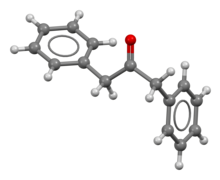 | |
 | |
| Names | |
|---|---|
| Preferred IUPAC name 1,3-Diphenylpropan-2-one | |
| Other names 1,3-Diphenylacetone | |
| Identifiers | |
3D model (JSmol) | |
| ChEBI | |
| ChEMBL | |
| ChemSpider | |
| ECHA InfoCard | 100.002.728 |
| EC Number |
|
PubChem CID | |
| UNII | |
CompTox Dashboard (EPA) | |
| |
| |
| Properties | |
| C15H14O | |
| Molar mass | 210.276 g·mol−1 |
| Appearance | white solid |
| Density | 1.069 g/cm3 |
| Melting point | 32 to 34 °C (90 to 93 °F; 305 to 307 K) |
| Boiling point | 330 °C (626 °F; 603 K) |
| −131.7·10−6 cm3/mol | |
| Hazards | |
| Flash point | 149.4 °C (300.9 °F; 422.5 K) |
Except where otherwise noted, data are given for materials in their standard state (at 25 °C [77 °F], 100 kPa). | |
Dibenzyl ketone, or 1,3-diphenylacetone, is an organic compound composed of two benzyl groups attached to a central carbonyl group. This results in the central carbonyl carbon atom being electrophilic and the two adjacent carbon atoms slightly nucleophilic. For this reason, dibenzyl ketone is frequently used in an aldol condensation reaction with benzil (a dicarbonyl) and base to create tetraphenylcyclopentadienone. Vera Bogdanovskaia is credited with the classification of dibenzyl ketone.